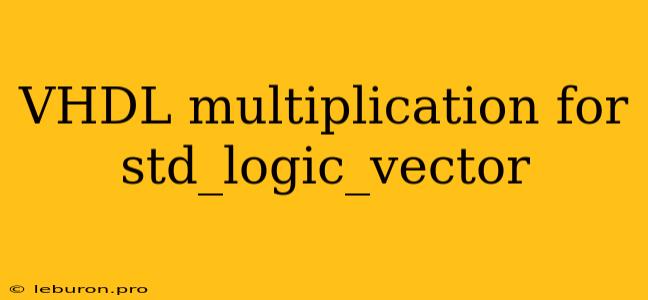Efficient VHDL Multiplication for std_logic_vector Data Types
In the world of digital design, VHDL (VHSIC Hardware Description Language) serves as a powerful tool for describing and simulating complex circuits. One fundamental arithmetic operation often encountered is multiplication, particularly when dealing with std_logic_vector data types, which represent binary values. This article delves into the intricacies of implementing efficient VHDL multiplication for std_logic_vector operands, exploring various techniques and their trade-offs.
Understanding std_logic_vector and Multiplication
std_logic_vector is a widely used data type in VHDL that allows representation of binary numbers with a fixed length. Each bit in a std_logic_vector can assume one of nine possible states: 'U' (Uninitialized), 'X' (Unknown), '0', '1', 'Z' (High Impedance), 'W' (Weak), 'L' (Low), 'H' (High), and '-' (Don't care).
Multiplication of std_logic_vector operands involves multiplying two binary numbers, resulting in a binary product. The product's bit width is typically larger than the input operands, accommodating the potential increase in the number of bits.
Approaches to VHDL Multiplication for std_logic_vector
Several methods can be employed to implement VHDL multiplication for std_logic_vector data types. Each approach possesses its own advantages and drawbacks in terms of hardware complexity, performance, and resource utilization.
1. Using the * Operator
The most intuitive approach is to utilize the built-in multiplication operator (*) provided by VHDL. However, it's important to understand that this operator inherently performs a signed multiplication.
library ieee;
use ieee.std_logic_1164.all;
entity multiplier_simple is
port (
a, b : std_logic_vector(7 downto 0);
product : out std_logic_vector(15 downto 0)
);
end entity;
architecture behavioral of multiplier_simple is
begin
product <= a * b;
end architecture;
This simple example demonstrates the use of the * operator for two 8-bit std_logic_vector inputs, resulting in a 16-bit output. While straightforward, it's crucial to note that signed multiplication might not be the desired behavior in all scenarios, particularly when dealing with unsigned binary values.
2. Implementing Multiplication Logic
For more control and potentially optimized resource utilization, a custom multiplication logic can be implemented using basic VHDL operations. The core concept involves iterating through each bit of the multiplicand and performing a series of additions, shifted according to the bit position.
library ieee;
use ieee.std_logic_1164.all;
entity multiplier_logic is
port (
a, b : std_logic_vector(7 downto 0);
product : out std_logic_vector(15 downto 0)
);
end entity;
architecture behavioral of multiplier_logic is
signal partial_product : std_logic_vector(15 downto 0) := (others => '0');
begin
for i in 0 to 7 loop
if b(i) = '1' then
partial_product <= partial_product + (a << i);
end if;
end loop;
product <= partial_product;
end architecture;
This code snippet showcases a simple implementation using a loop and a partial_product signal to accumulate the results of individual multiplications. While providing flexibility, this method often results in a higher gate count compared to dedicated multipliers.
3. Utilizing Dedicated Multipliers
Modern FPGAs and ASICs often incorporate dedicated hardware multipliers. These multipliers are designed to efficiently perform multiplication operations using specialized hardware blocks. The use of dedicated multipliers can significantly improve performance and reduce resource utilization compared to custom logic implementations.
To utilize dedicated multipliers, VHDL offers various synthesis directives and attributes. For example, the (* use_dsp = "yes" *) attribute can be used to guide the synthesis tool to map the multiplication operation to a dedicated DSP block.
4. Pipelined Multiplication for Higher Throughput
When dealing with high-speed applications, pipelining can be used to enhance the throughput of multiplication operations. Pipelined multiplication involves dividing the multiplication process into multiple stages, allowing the execution of multiple multiplications concurrently. This can significantly reduce the latency of each multiplication, leading to higher overall throughput.
library ieee;
use ieee.std_logic_1164.all;
entity multiplier_pipelined is
port (
clk : in std_logic;
a, b : in std_logic_vector(7 downto 0);
product : out std_logic_vector(15 downto 0)
);
end entity;
architecture behavioral of multiplier_pipelined is
signal partial_product : std_logic_vector(15 downto 0) := (others => '0');
begin
process (clk)
begin
if rising_edge(clk) then
if b(0) = '1' then
partial_product <= a;
end if;
end if;
end process;
process (clk)
begin
if rising_edge(clk) then
if b(1) = '1' then
partial_product <= partial_product + (a << 1);
end if;
end if;
end process;
-- ... similarly for other bits of b
product <= partial_product;
end architecture;
This example demonstrates a simple pipelined multiplication using multiple processes. Each process represents a stage in the pipeline, calculating the partial product based on a specific bit of the multiplicand. This allows the multiplication to be performed in a pipelined fashion, increasing throughput.
Choosing the Right Approach
Selecting the most appropriate approach for VHDL multiplication of std_logic_vector depends on various factors, including the desired performance, available hardware resources, and complexity constraints.
- For basic applications and limited resource constraints, utilizing the built-in
*operator or implementing custom multiplication logic can be suitable. - For performance-critical applications, dedicated multipliers or pipelined implementations offer significant advantages.
- When dealing with unsigned values, it's crucial to ensure that the chosen method correctly handles unsigned arithmetic.
Conclusion
Understanding VHDL multiplication for std_logic_vector is essential for any digital designer working with binary arithmetic. Various techniques, including the * operator, custom logic implementation, dedicated multipliers, and pipelining, provide different levels of performance and resource utilization. By carefully considering the specific requirements of each application, the optimal method can be chosen to achieve the desired functionality and performance. The choice ultimately depends on the specific design constraints and desired trade-offs between performance, hardware complexity, and resource usage.
